Homecoming 2022 will feature the first-ever matchup between Arkansas and Liberty. Bowl eligibility is on the line for the Hogs, while Liberty – already 23rd in the AP poll – can break into the CFP top 25 with a win.
This matchup is another product of Arkansas’ weird scheduling. The Hogs could easily have found a low-end Sun Belt, Conference USA, or MAC opponent for this game, but instead found Liberty, a program coached by a former SEC coach who finished in the top 25 just a couple years ago.
Meet the Flames
Confused by any of the advanced stats you see here? Be sure to check out the glossary.
We debuted a new recap format in the Auburn Box Score Breakdown, so here’s a simpler, cleaner preview format:

Our topline number is now Predicted Points Added (PPA) per Drive, which is kind of an all-compassing measure of how good a team as at moving the football (offense) or preventing the opponent from moving the football (defense). Drives that have good plays, gain some yards, flip field position, but don’t score are still worth something, although nothing beats actually punching it into the end zone.
As discussed earlier this week, the Flames are 7-1 against a weak schedule (117th). They’ve had several close calls (four overtimes against Southern Miss, 21-20 over FCS Gardner-Webb), but their lone loss was tossup 37-36 defeat to pretty good Wake Forest team.
The poor strength of schedule makes it somewhat difficult to evaluate Liberty, as does the fact that they are independent, because they don’t have a shared group of common opponents to do comparative evaluations on, like you do with a conference. They looked much better against BYU than Arkansas did, but BYU had to cross two time zones to play that game, and we have a lot of history showing that teams crossing multiple time zones usually play poorly (see: Oregon-Georgia, Utah-Florida, plus the famous Stanford-Northwestern “body clock” game in 2015).
Scouting Report
Liberty’s offense is keyed by an explosive run game that’s a threat to rip off a big run at any time. But injuries at the quarterback position have hurt this offense, which struggles to throw the ball. The offensive line is also a major weakness, struggling to consistently open up holes in the run game and protect the passer. Turnovers, particularly interceptions, have been an issue.
The defense is extremely strong, especially against the pass, where the Flames get plenty of sacks and pick off passes at a high rate. There are some vulnerabilities against the run, but overall, this is a very good defense.
Names to Know
- Dae Dae Hunter. Given the passing game and offensive line issues, Hunter’s season has been pretty impressive. He’s averaging almost seven yards per carry and creates a lot of huge runs. If the Flames struggle to pass, he will be their offense.
- Robert Rahimi. The Flames have picked off 11 passes this season, led by Rahimi’s four. The junior safety commands a ball-hawking back end that is very strong against the pass.
- Dre Butler. SEC transfers are part of Liberty’s roster-building strategy. Enter Butler, a former four-star recruit at Auburn who now plays interior defensive line for Liberty. Butler isn’t Liberty’s most productive defensive lineman, but he’s the only one on the two-deep who weighs more than 280 pounds. BYU’s tiny defensive line got steamrolled by the Hogs, so Liberty needs its big men to hold up in the trenches.
When Arkansas has the ball
It’s a shame (for Liberty, at least) that the Flames have had so many injuries at quarterback, because the defense is the best Hugh Freeze has fielded so far.
Liberty’s defense is coordinated by Josh Aldridge, an alum of Harding and former star for the Bison.

Liberty’s base defense is a 3-3-5 that at times looks like a 3-4 with smaller personnel. Their line is basically always in a “Tite” front to discourage runs between the tackles, while the two outside linebackers are generally positioned aggressively on the edges:

This was their alignment on about 80% of snaps against BYU, and has been the primary alignment in other games that I’ve watched. A few notes:
- Those edge guys are really dangerous against read plays. Their objective is to disrupt everything the offense is trying to do. On passes, at least one is rushing, but one sometimes drops into coverage.
- There’s only one linebacker who is actually backing up the line. Any run play that breaks through the front is capable of creating a huge gain.
- Despite the disruption on the edge, Liberty fails to properly set the edge way too often, largely due to their aggressiveness. Examples below.
- The secondary is in a classic Cover 1 look. Note the very deep single-high safety and the outside leverage by the cornerbacks. The corners are going to try and force deep routes back inside where there is safety help.
That outside leverage by the cornerbacks leaves the defense vulnerable to inside-breaking routes like slants and crossers. Here’s how the still pic above turned out:
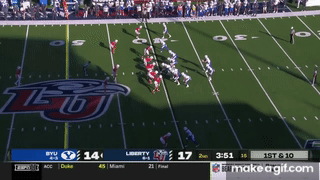
Despite the completed pass, note the heavy pressure that Liberty gets. That’s a theme, and it really wore BYU out over the course of the game.
The other vulnerability for Liberty is the edge. The narrow alignment of the defensive line plus the aggressiveness by the edge defenders can cause problems, as BYU exploited repeatedly:
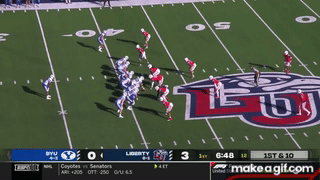
And repeatedly (this is three plays later):
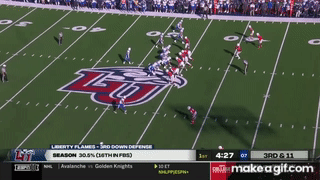
Of course, BYU jumped to a 14-3 lead and then didn’t score again, allowing Liberty to have the final 38 points. The main reason why? That pass rush:
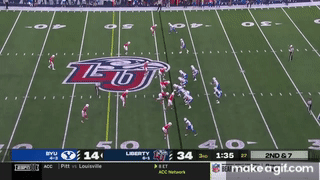
This interception didn’t count (defender bobbled it going out of bounds), but that’s still terrible mechanics by Jaren Hall. He got worn down during this game and made repeated bad decisions after the first quarter.
The Cougars were also terrified of the Tite front on the Liberty defense, calling just six runs for their running backs in the entire game, and only four of those went between the tackles.
You can bet that Kendal Briles isn’t going to call a scared game like BYU did. Inside zone is the Hogs’ bread-and-butter run play, and Arkansas will run it. The best inside zone run to use against a Tite front is Split Zone. Good news: that happens to be one of Arkansas’ most effective runs this season:
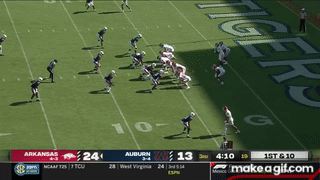
The Hogs have run some version of the bluff/split zone 44 times this season for 339 yards (7.7 per rush). Rocket Sanders’ ability to bounce these runs outside (that’s part of the design of a split zone) is what makes them so dangerous against Tite fronts.

Liberty will be vulnerable to the run. They blow up a decent number of plays, but big runs are definitely possible against them: they rank just 46th in allowing runs of 6+ and 36th in allowing runs of 10+ (explosive runs).
So I think the Hogs will run the ball just fine. But through the air is an intriguing matchup:

As mentioned above, Liberty wants to play a lot of man, although it’s worth noting they were heavier on zone against Wake Forest, the only team they’ve faced that had receivers that could truly out-athlete them.
Facing Arkansas’ offense isn’t fun for any defense, because you have to pick your poison. Zone allows you to get more defenders into the box to stop the run, but KJ Jefferson has been shredding zone, especially in the last few games. That’s one of the reasons why the Hogs have come out throwing on early downs recently. If Liberty tries zone, expect the Hogs to be more aggressive through the air.
But if you play man, while you can force Jefferson to make throws he’s less comfortable with (slants, in particular), it’s much harder to stack the box. Against South Carolina’s man-heavy defense, the Hogs simply ran it down their throats and barely needed to pass.
So I think that Briles will do what he normally does and use the first couple of drives to make the defense show its cards. If the Flames show zone, I think the Hogs will keep throwing on early downs. If its man, then this could end up looking like the Carolina game, with 60 rushing attempts or more.
When Liberty has the ball
When you saw Liberty on the schedule and remembered that Hugh Freeze was coaching there, you might have expected a dangerous offense. But you would be wrong.
To be fair, Liberty has had some unfortunate quarterback luck. To replace third-round pick Malik Willis, the Flames signed Charlie Brewer, a four-year starter at Baylor who begun the 2021 season as Utah’s starter before being injured and then replaced. But Brewer was hurt in the first quarter of Liberty’s opener against Southern Miss. Backup Kaidon Salter finished that game and started the next three, but he too was hurt and lost for the year. Liberty’s passing leader is Johnathan Bennett, a former two-star recruit who now has four starts and five appearances.
Brewer was healthy for the BYU game and played a few snaps without throwing a pass. The biggest question heading into this game is whether Freeze feels confident enough to start Brewer, who has four pass attempts this season.

The Flames’ defense feeds the offense. They often start in great field position (8th), but they are unproductive on early downs (81st in standard downs EPA/play), which forces them to play catch-up. They can create explosive plays, especially in the run game, but when those aren’t coming, their offense tends to bog down.
If Bennett is the quarterback, he’s more dangerous as a scrambler than as a thrower:
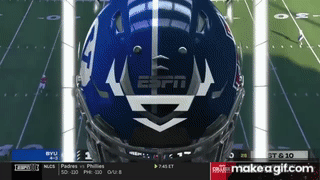
As a passer, Bennett is not accurate at all. He’s already tossed five interceptions in four starts, and many of them are just wild passes rather than bad decisions:
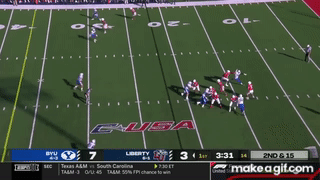
Brewer is a major upgrade as a passer, but Liberty would lose some of the scrambling ability, and there would probably be some rust as well.
So Liberty will understandably be fairly run-heavy. Schematically, Freeze was on the cutting edge of college offense back when the hurry-up, no-huddle was more of a novelty. As defenses adapted, Freeze’s offense became much more conventional.
Liberty’s run game is heavy on reads, like Arkansas. Freeze was obviously watching Arkansas-BYU film, as the Flames pulled out the same G Counter that Sanders scored a long touchdown on against the Cougars:
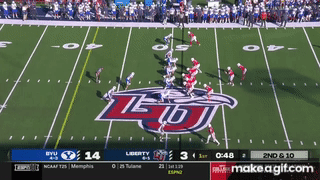
Liberty ran this several times and gashed BYU every time with it.
But the Flames are multiple, like the Hogs, so you’ll see the zone running game too. Later in that drive, BYU is inexplicably not in a goal line package, so Freeze calls an inside zone for an easy touchdown:
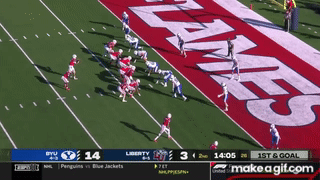
Liberty’s offensive line has struggled at times this year, so a lot of runs don’t go anywhere. That’s why the guy to key on is running back Dae Dae Hunter. He’s a threat to break tackles at the second level and create huge runs, which Liberty depends on.
On this play, Freeze does a great job of dressing up a simple outside zone with motion to the backside, which creates eye candy for the BYU defense and sets up the home run:
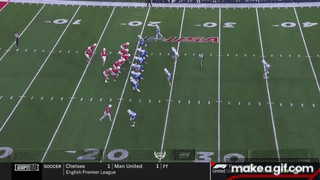
Okay, so that’s some great running by Hunter… but goodness, BYU. That is awful tackling.

The explosive runs stat is the only green part for Liberty. As bad as the Hogs have been defensively, they’ve still managed to prevent huge runs. And if they stay in the four-man front (as we expect they will now that the secondary is healthy), they’ll give themselves a better chance to stop the run altogether.

Meanwhile… who’s going to win the matchup through the air?
You may notice that Liberty’s EPA/pass (113th) is much worse than either its efficiency (92nd) or explosiveness (62nd). Why is that? The simple answer is that Liberty’s unsuccessful plays are often very unsuccessful.
First are interceptions, mentioned above. Second are sacks (116th). Liberty’s offensive line has had a rough year:
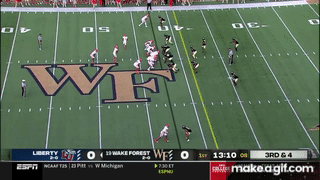
A lot of dropback passes end up looking like this, where no clean pocket ever forms. That will be some of the danger if Liberty decides to start Brewer, who is less mobile than Bennett. Arkansas blitzed just two Auburn dropbacks last week and still managed to get pressure or a sack on one-quarter of dropbacks. That’s the benefit of a four-man front.
Bennett’s scrambling helps negate some of the rush, though that hurts the Flames’ ability to push the ball downfield. Freeze also calls a lot of rollouts and sprintouts, as Bennett doesn’t have a big dropoff in accuracy when throwing on the run.
Finally, one of Freeze’s big innovations at Ole Miss was aggressive use of empty sets to take pressure off his quarterback:
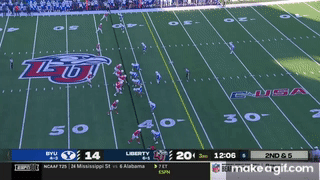
Liberty will leave Hunter in the game as a receiver for a lot of these, so Arkansas can’t easily sub guys like Bumper Pool out of the game based on the Flames’ personnel. That creates a lot of risk, as Pool is a major liability as a pass defender in space. If Liberty has issues running the ball, expect to see a ton of empty.
Keys to the Game
- Tackle in space. Liberty’s offensive effectiveness is limited by a poor offensive line and quarterback play, but Hugh Freeze still knows how to get the ball to his guys in space. The Hogs cannot allow 8-yard gains to turn into 60-yard gains because of missed tackles.
- Receivers win 1-on-1s. Arkansas’ receiving corps has had a fantastic few games after having some issues with drops earlier in the season. Now they get a salty secondary that will be aggressive and jump in front of passes. KJ Jefferson is a fairly conservative passer who generally avoids throwing into tight windows. His receivers need to provide a good opening so the Hogs can keep pushing the ball down the field.
- Take care of business. One thing everyone talked about regarding Sam Pittman-coached Arkansas teams across 2020 and 2021 is how hard they played every game. That Missouri State game was unique in that it was the first team we’d seen a Pittman-coached team take an opponent unseriously and play so sloppy and unfocused. This game is very much a trap game: an opponent good enough to pull an upset but without much fanfare coming to town in the middle of conference play. If the Hogs fall behind 17-0 in this one like they did against Missouri State, they may not be able to climb out of it.
Thanks for reading! Be sure to follow us on Twitter.
The latest from Fayette Villains, straight to your inbox
Enter your email to subscribe and receive new post alerts and other updates. You can unsubscribe at any time.